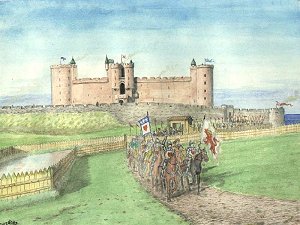|
Artist: Andrew Spratt Custodian of Dirleton Castle. These images are the copyright of Mr. Spratt who has generously given permission to display them here. For a complete index of Mr. Spratt's castles on this site click here. Other galleries of Mr. Spratt's work may be viewed at Clan Douglas and Clan Sinclair. Click on the images above to view a larger size. |
||||
|
|
||||
|
Three miles east of North Berwick on a cliff top promontory jutting out into the Firth of Forth, opposite the Bass Rock Island, perches the great red curtain wall of of Tantallon castle, seat of the infamous Red Douglas family. The castle was built after 1350 by William 1st Earl of Douglas. Who having spent his youth in France at Chateaux Galliard in Normandy and as an adult fought at the battle of Poitiers in 1356 on behalf of the French King John II 'the Good'. It was no surprise then as to why Tantallon was based on a French Chateaux. The main curtain wall was protected by three towers, on the west end 'the Douglas tower' (almost a Donjon like that at Coucy-le-Chateaux north of Paris, which was also influential in the construction of nearby Dirleton castle a Century earlier), a central mid-tower gatehouse with drawbridge with conical roofed huge bartizans and at the east end a narrow D-plan ' East tower'. Infont of these were three ditches, two being great dry ditches and the outermost being water filled by the 'Tantallon burn' forming a deep moat protecting the southern landward entry. On the western side was a further group of outer ditches and wooden pallisades as far as the present day Castleton farm or 'castle-town' village as it would have been known. In the early 1500's these pallisades were replaced by outerwalls with gun-loops for cannon. Also a Ravelin (V-shaped) cannon platform was added to further protect these outer works.
The abortive siege in 1491 by King James IV (1488-1513) of Scots. The two sieges by King James V (1513-1542) of Scots in 1528/29 and finally the destruction of Tantallon by Oliver Cromwell in 1651 after a 12 day bombardment.Today the huge red sandstone walls of Tantallon bears the scars of these many conflicts but still stands proud like some kind of giant sentinel guarding the mouth of the Firth of Forth for any future would-be invaders.
Andrew
Spratt
| ||||

